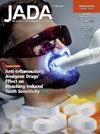Association of dietary and plasma fatty acids with periodontitis
IF 3.1
2区 医学
Q1 DENTISTRY, ORAL SURGERY & MEDICINE
引用次数: 0
Abstract
Background
The authors aimed to explore the association of fatty acids with periodontitis and its severity and to assess causality using Mendelian randomization (MR) analyses.
Methods
Data for participants with complete data were extracted from the 2009-2014 National Health and Nutrition Examination Survey. Weighted logistic regression was used to explore the relationship between dietary fatty acids and periodontitis and its severity. Univariable and multivariable MR analyses were performed to explore the causal association between plasma fatty acids and periodontitis.
Results
Two types of saturated fatty acids (hexadecanoic C16:0, octadecanoic C18:0) and monounsaturated fatty acids (hexadecenoic C16:1, docosenoic C22:1) and 3 types of polyunsaturated fatty acids (eicosatetraenoic C20:4, eicosapentaenoic C20:5, docosahexaenoic C22:6) were positively associated with periodontitis. Conversely, octadecadienoic (C18:2, a type of polyunsaturated fatty acid), total polyunsaturated fatty acids, and omega-6 fatty acids were negatively associated with periodontitis. Similar association patterns were also found between these fatty acids and the severity of periodontitis. Results of MR analyses revealed that no significant association was found between plasma fatty acids and periodontitis.
Conclusions
The authors provided evidence of significant associations between certain fatty acids and periodontitis and its severity, highlighting their contributory role, although the evidence does not support a causal role based on the results of MR-based analyses.
Practical Implications
The results of this study support a contributory or inhibitory role of fatty acids in the progression of periodontitis, although not as a direct cause, and underscored the importance of maintaining a balanced dietary lipid profile for periodontal health.
饮食和血浆脂肪酸与牙周炎的关系:来自2009-2014年全国健康与营养调查和孟德尔随机研究的结果。
背景:作者旨在探讨脂肪酸与牙周炎及其严重程度的关系,并利用孟德尔随机化(MR)分析评估因果关系。方法:数据完整的参与者数据来源于2009-2014年全国健康与营养检查调查。采用加权logistic回归法探讨膳食脂肪酸与牙周炎及其严重程度的关系。单变量和多变量磁共振分析探讨血浆脂肪酸和牙周炎之间的因果关系。结果:两种饱和脂肪酸(十六烷C16:0、十八烷C18:0)、单不饱和脂肪酸(十六烷C16:1、二十烷C22:1)和3种多不饱和脂肪酸(二十烷四烯C20:4、二十烷五烯C20:5、二十二碳六烯C22:6)与牙周炎呈正相关。相反,十八烯二烯酸(C18:2,一种多不饱和脂肪酸)、总多不饱和脂肪酸和ω -6脂肪酸与牙周炎呈负相关。在这些脂肪酸和牙周炎的严重程度之间也发现了类似的关联模式。磁共振分析结果显示,血浆脂肪酸与牙周炎之间没有明显的联系。结论:作者提供了某些脂肪酸与牙周炎及其严重程度之间存在显著关联的证据,强调了它们的促进作用,尽管基于磁共振分析结果的证据不支持因果关系。实际意义:本研究结果支持脂肪酸在牙周炎进展中的促进或抑制作用,尽管不是直接原因,并强调了维持平衡的饮食脂质对牙周健康的重要性。
本文章由计算机程序翻译,如有差异,请以英文原文为准。
求助全文
约1分钟内获得全文
求助全文
来源期刊

Journal of the American Dental Association
医学-牙科与口腔外科
CiteScore
5.30
自引率
10.30%
发文量
221
审稿时长
34 days
期刊介绍:
There is not a single source or solution to help dentists in their quest for lifelong learning, improving dental practice, and dental well-being. JADA+, along with The Journal of the American Dental Association, is striving to do just that, bringing together practical content covering dentistry topics and procedures to help dentists—both general dentists and specialists—provide better patient care and improve oral health and well-being. This is a work in progress; as we add more content, covering more topics of interest, it will continue to expand, becoming an ever-more essential source of oral health knowledge.
 求助内容:
求助内容: 应助结果提醒方式:
应助结果提醒方式:


